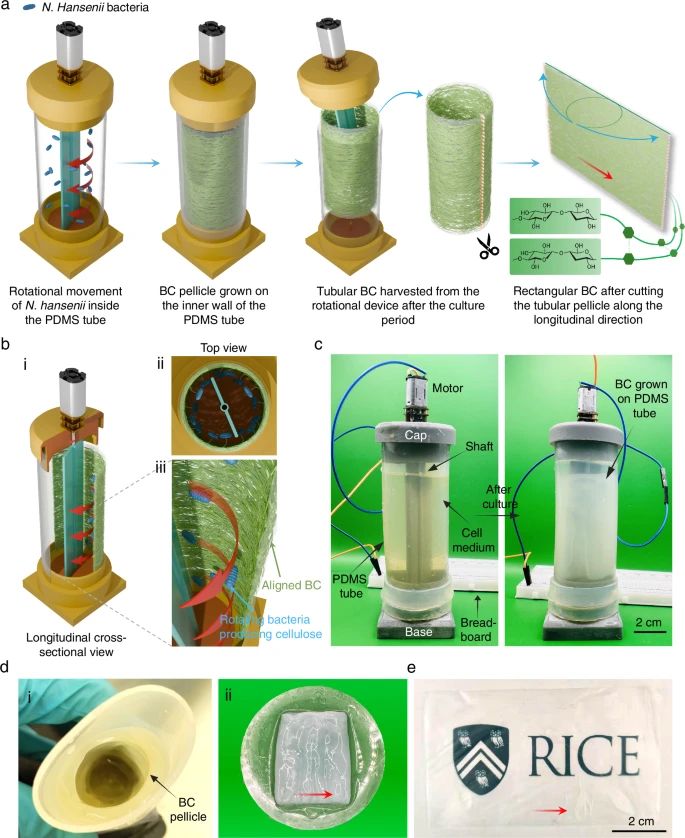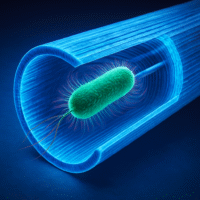You know, bacterial cellulose – or BC as researchers like to call it – is actually pretty amazing stuff. It’s got this huge potential to replace synthetic polymers since it’s biodegradable and all, mainly because these tiny nanoscale building blocks are incredibly strong. But here’s the thing – we haven’t really been able to tap into BC’s full mechanical potential yet, and there’s basically two main reasons why.
First off all getting those nanofibrils to align properly at a larger scale is really tricky. And second, trying to mix in other nano-fillers to make the material more versatile.
But some clever researchers figured out a way around these problems. They came up with this pretty straightforward method – it’s just one step, which is nice, and you can scale it up too. Basically, they’re biosynthesizing these tough BC sheets where the nanofibrils are actually aligned the way they want them.
Here’s how it works: they designed this custom rotational culture setup where they grow these Novacitomonas hansenii bacteria (quite a mouthful, right?) inside an oxygen-permeable tube that’s cylindrical. There’s this central shaft that keeps spinning continuously, and that creates directional fluid flow. This generates these shear forces between the spinning shaft and the tube walls.
What happens next is pretty cool – these shear forces basically force the bacteria to move in a specific direction, and as they do that, they deposit these anisotropic BC nanofibrils layer by layer right on the tube’s inner surface. It’s like they’re building the material in-situ as they grow.
The researchers found that 60 rpm works best, and they let the whole process run for about 10 days. Pretty neat solution to what seemed like a really complex problem, honestly.

a) Schematic of rotational culture system for aligned BC production.
b) Device cross-sections during BC formation.
c) Culture device before/after cellulose formation.
d) BC pellicle on (i) PDMS tube and (ii) glass plate.
e) Transparent dried BC sheet showing alignment. (CREDIT: NATURE)
Confirming Nanofibril Alignment
So, how did they actually prove that this rotational method was working? Well, they didn’t just take one approach – they threw multiple techniques at it to really confirm what was happening with those nanofibrils.
First up was wide-angle X-ray scattering, or WAXS as it’s commonly called. This technique showed some pretty impressive numbers – the Herman’s Orientation parameter (which basically measures how well-aligned things are) came in at around 0.489 for the rotational BC. Compare that to regular static BC which only hit 0.027, and you can see there’s a huge difference there. That’s like night and day in terms of alignment quality.
Then they brought in the big visual guns – high-resolution scanning electron microscopy and atomic force microscopy (SEM and AFM respectively). These basically let you actually see what’s going on at the nanoscale, and sure enough, they could visually confirm that those nanofibrils in the rotational BC were nicely aligned and packed together much more compactly than usual.
But they didn’t stop there. They also used polarized light microscopy, which is this neat technique that can reveal alignment through these characteristic dark and light patterns. And guess what? The rotational BC showed exactly those patterns you’d expect from well-aligned material, while the randomly oriented static BC just looked… well, random. No distinct patterns at all.
It’s pretty satisfying when multiple different techniques all point to the same conclusion, you know? Really gives you confidence that the method is actually doing what it’s supposed to do.
Unmatched Mechanical Strength
This enhanced nanofibril alignment directly translates into superior mechanical properties:
So we found that when you rotate these BC sheets during production, their tensile strength shoots up to around 436 MPa – that’s roughly a 137% bump compared to the static ones. Pretty impressive actually, since this is apparently the highest tensile strength anyone’s gotten from BC straight out of culture without having to do extra stuff like stretching it afterwards.
The Young’s modulus also got a nice boost of about 96%, jumping from 16.6 GPa all the way to 32.6 GPa.
But here’s what really caught our attention – the toughness (basically how much work it takes to break the thing) went up by around 166%. Now that’s interesting because usually in materials science, you can’t have both super strong AND super tough at the same time. It’s like one of those annoying trade-offs you always run into. But somehow this rotation method managed to pull off both.
We think what’s happening is that the rotation creates this denser structure with fewer pores, plus the nanofibrils get straightened out which leads to better hydrogen bonding between them.
Another cool thing – these aligned BC sheets are really good at handling repeated stress. We put them through 10,000 loading cycles and they still kept their structure and tensile properties intact. That’s some solid fatigue resistance right there.
Hybrid Nanosheets with Multifunctionality
The rotational culture method also facilitates the creation of robust multifunctional hybrid nanosheets. By simply adding hexagonal boron nitride nanosheets (BNNS) to the nutrient media, the continuous rotational flow ensures their homogeneous distribution and intercalation within the growing BC network. These BCBN hybrid nanosheets are flat, transparent, and flexible. The incorporation of BNNS further significantly boosts their mechanical and thermal properties:
Tensile strength increased to up to ~553 MPa.
Toughness (WoF) increased by ~338% compared to static BC.
Thermal stability improved up to 300°C, and they exhibited a three times faster rate of heat dissipation compared to control BC samples.
Applications and Future Outlook
This whole biofabrication thing we’ve been working on? It’s pretty versatile actually. We’re getting these aligned BC materials that are both strong and can do multiple things at once, plus we can make hybrids with other stuff too.
The applications are all over the place – we’re talking structural materials, thermal management (so like heat control), packaging, textiles, even green electronics and energy storage. It’s kind of exciting how many different directions this could go.
What’s really neat about this method is that it’s flexible enough to work with other tiny building blocks too. So basically, we can mix and match different nanoscale materials depending on what properties we want. Need something more conductive? Throw in some conductive nanoparticles. Want better thermal properties? Add something for that. It’s like having a toolkit where you can customize the final product based on what you actually need it to do.
This opens up a lot of doors for future applications that we probably haven’t even thought of yet. The fact that we can tune the functionality on demand means we’re not locked into just one type of material or one specific use case, which is pretty cool from a development standpoint.
📚 Read More Topics:
















